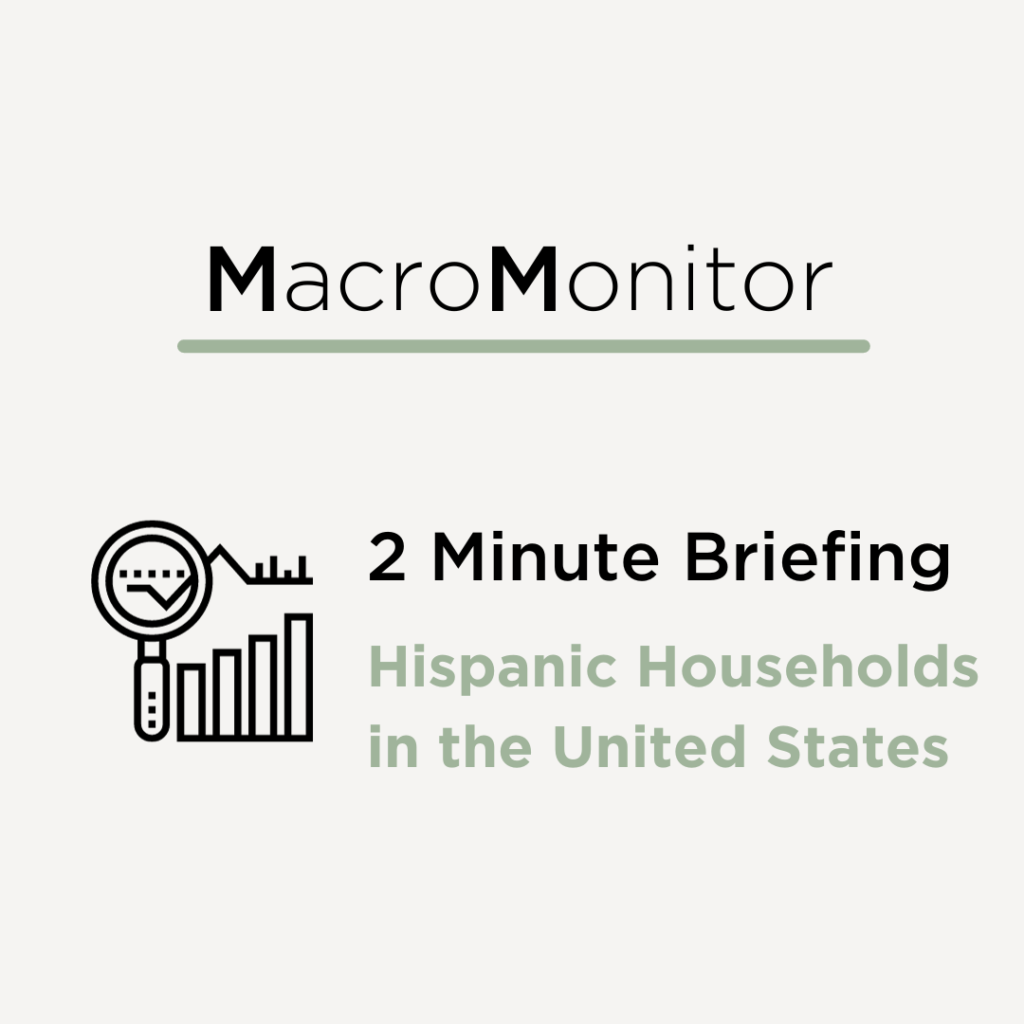Hispanic Households in the United States
Significance:
Hispanic Households (HHs) are the fastest growing segment of the United States population: The 2022-23 MacroMonitor reports 17% of all US HHs have at least one Hispanic head. In 2022, nearly 5 million Hispanic-owned businesses alone contributed more than $800 billon to the US economy. The US Census Bureau projects the Hispanic population will reach 111 million by 2060. As populations grow, so should opportunities for financial-service providers.
Background:
Spanish-speaking people inhabited North America before English-speaking people: St. Augustine (FL) was founded in 1565 by the Spanish; Jamestown (VA) was founded 1607 by the English. Spanish explorers immigrated for economic reasons and to spread their religion; the English to spread their influence and escape religious persecution. Both groups pushed native Americans further inland as the Spanish settled in the West and Southeast Coasts and the English settled in the Mid-Atlantic and Northeast coasts. Today’s Hispanic immigrants are increasingly moving into states such as Colorado, Illinois, and New Jersey, and “bussed” out of states such as Texas and Florida where “Spanglish” is commonly spoken. Whereas 20 years ago Hispanics worked to learn the English language, today speaking Spanish is an important skill and one which many Spanish-speaking parents encourage their American-born children to retain or to learn. The proportion of Hispanics who speak Spanish at home has fallen from 78% in 2000 to 68% in 2021, with implications for institutions’ communications to more educated and affluent Hispanic subpopulations.

The good news is that the proportion of Hispanic HHs living in poverty has declined over the past decade; the bad news is, poverty levels are still well above the national average. Hispanics suffer the country’s largest pay gaps. Even college-educated Hispanics (both male and female) are paid significantly less than Whites or Blacks. Some experts point out that, “Failure to address systemic economic inequalities may act as a drag on the nation’s future prosperity.” The admonition applies to all diversity groups.
Behaviors and Attitudes:
The 2023 Hispanic MacroMonitor offers Hispanic HH subpopulations with sufficient samples for analysis: Mexican (net), Puerto Rican, Cuban (net), and Other Spanish HHs. Mexican HHs (Mexican, Mexican American and Chicano) represent the largest share (61%) of Hispanic HHs; Cuban HHs (Cuban and Cuban American) the smallest (6%). Financially, Cuban HHs are doing better than other Hispanic populations because the first wave of immigrants (1959) were predominantly the educated, wealthy, and middle-class fleeing Castro’s communist government. Most were bilingual and financially able to establish themselves shortly after arrival—buy homes, build businesses, save, and invest. Typically, less educated Hispanics struggle financially. One-half of Mexican HH heads have a HS diploma or less in comparison with only 13% of Cuban HHs. One example of how educational differences translate to financial stability are savings rates: Mexican HHs average $34k in savings, Cubans $80k.

Regardless of race or ethnicity, people everywhere tend to gravitate to places where there are other people like them whether it’s Cubans to Miami (FL), Puerto Ricans and Mexicans to barrios, or Whites to suburban gated communities and redlined neighborhoods. Hispanic HHs are more likely than all US HHs to be urban dwellers who live in neighborhoods with locally owned businesses and restaurants but rarely a large grocery store or national bank presence. Wealthier, financially literate Hispanic HHs with suburban single-family homes are more likely to use national financial services providers than most Hispanic HHs. Overall, Hispanic HHs’ trust in depositories (banks and credit unions) is significantly below average. Only discount stock brokerages and consumer finance companies enjoy a high degree of trust; incidences are small; 6.2% for stock brokerages and 6.4% for consumer finance companies. Neo-banks have the same trust score as consumer finance companies—6.4%.
Only one-quarter of Hispanic HHs cite providing for retirement as their most important goal for their households’ savings and investments, fewer than other households. Limited disposable income is a problem. Homeownership is an attractive ‘investment’ as a home provides immediate shelter, a way to build equity, and an endless source of D-I-Y projects that increase its value. Also, a home can be bequeathed or sold to provide an inheritance. Unlike many Black HHs who see life insurance as a good way to protect their family’s future, or many Asian HHs who have financial assets, Hispanic HHs seem to prefer investing in tangible property.
Insights
- If your intent is to value Hispanic customers, demonstrate that you value Hispanic employees.
- Financial literacy is the result of education, experience, confidence, and enough money to do more than meet monthly living expenses. How can your organization support people’s basic financial needs?
- Financial institutions with a local presence (even an ATM) can be more appealing to Hispanic customers than a national provider online. Large institutions are not automatically considered better. Smaller institutions are often perceived as more willing to understand, share, reflect, and invest in Hispanic communities.
- Although Hispanic HHs use the internet and social media frequently, financial institution apps are not a substitute for a physical presence to attract and serve Hispanic customers. A personal relationship with your organization can ameliorate trust issues.
Don’t miss the next in the series of 2-Minute Brief videos: Hispanic Households on RFI Global MacroMonitor.
Ask us about differences among Hispanic households and The 2023 Hispanic MacroMonitor program.
References:
Latinos’ Views of and Experiences With the Spanish Language
Latinos value speaking Spanish — a lot
52% of Hispanic college students considered leaving school last year
Facts on Latinos in the U.S.
https://www.pewresearch.org/hispanic/fact-sheet/latinos-in-the-us-fact-sheet/
How Latinos are doing in poverty battle
The Myriad Stories Behind Hispanic Retirement Saving
https://crr.bc.edu/the-myriad-stories-behind-hispanic-retirement-saving/
These Latino Leaders Are Reshaping Their Industries–and the Country
https://time.com/6315421/america-latin-leaders-2023/
Spanish-language content and culturally relevant materials around disasters
How Latinos are doing in poverty battle
The Myriad Stories Behind Hispanic Retirement Saving
https://crr.bc.edu/the-myriad-stories-behind-hispanic-retirement-saving/
Rhode Island Latinas running for Congress illustrate state’s shift
https://www.axios.com/2023/07/11/rhode-island-congress-sabina-matos
America’s Bosses grapple with threats to diversity policies








































































/NQA-ISO-27001-Logo-UKAS.jpg)